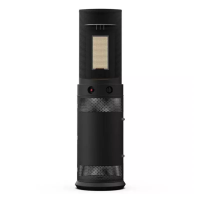Mimosa Backhaul Help Content
Mimosa Backhaul Link
Copyright © 2014 Mimosa Page 118
TDMA Configuration Settings
The TDMA Configuration panel contains controls for configuring and fine tuning TDMA performance. One side of the
radio link must be set as an Access point, and the other set as a Station. The Station inherits the other settings from
the AP, so the other fields are grayed out and not accessible when Station is selected.
B5/B5c
Wireless Mode - Choose whether the device will act as an Access Point or a Station.
●
Multi Client Mode - Enable or disable PTMP operation with other Mimosa Backhaul radios with compatible
●
firmware. Changing this value requires a reboot. When enabled, the TDMA window is 8 ms and can not be
changed, and only 50/50 traffic split options are available. If connecting a B5-Lite as a client, the B5-Lite will
only connect on one channel, and will not operate in "FD" mode.
Gender - Traffic Split - The radio can be configured to allocate bandwidth symmetrically (50/50) or biased
●
towards downstream (75/25) in environments where traffic direction is expected to be heavier in one direction
than the other. With an asymmetrical split, the local radio is represented first in the slash notation,
(local/remote). For example, in the (75/25) split, the local radio gets 75, while the remote radio gets 25. If
"Auto" is selected the radio will automatically determine, based upon traffic flow, which ratio will be used. The
radio will continue to evaluate the flow and adjust accordingly.
TDMA Window - Determines the length of the transmit time slot in milliseconds. If "Auto" is selected as the
●
Gender-Traffic Split, this value is set dynamically.
Note: To enable spectrum reuse, both Gender-Traffic Split and TDMA Window must each be set to the same value
for all collocated radios. Further, "Auto" must not be selected as the TDMA Window when radios are collocated.
B5-Lite
Wireless Mode - Choose whether the device will act as an Access Point or a Station.
●
Gender - Traffic Split - The radio can be configured to allocate bandwidth symmetrically (50/50) or biased
●
towards downstream (75/25) in environments where traffic direction is expected to be heavier in one direction
than the other. With an asymmetrical split, the local radio is represented first in the slash notation,
(local/remote). For example, in the (75/25) split, the local radio gets 75, while the remote radio gets 25. If
"Auto" is selected the radio will automatically determine, based upon traffic flow, which ratio will be used. The
radio will continue to evaluate the flow and adjust accordingly.
TDMA Window - Determines the length of the transmit time slot in milliseconds. If "Auto" is selected as the
●
Gender-Traffic Split, this value is set dynamically.
B11
Wireless Mode - Choose whether the device will act as an Access Point or a Station.
●
Gender - Traffic Split - The radio can be configured to allocate bandwidth symmetrically (50/50) or biased
●
towards downstream (75/25) in environments where traffic direction is expected to be heavier in one direction
than the other. With an asymmetrical split, the local radio is represented first in the slash notation,
(local/remote). For example, in the (75/25) split, the local radio gets 75, while the remote radio gets 25. If
"Auto" is selected the radio will automatically determine, based upon traffic flow, which ratio will be used. The
radio will continue to evaluate the flow and adjust accordingly.
TDMA Window - Determines the length of the transmit time slot in milliseconds. If "Auto" is selected as the
●
Gender-Traffic Split, this value is set dynamically.
Note: To enable spectrum reuse, both Gender-Traffic Split and TDMA Window must each be set to the same value
for all collocated radios. Further, "Auto" must not be selected as the TDMA Window when radios are collocated and
sharing the same frequencies.

